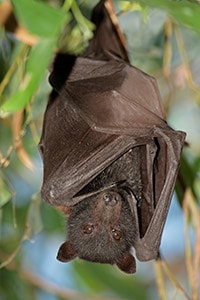Few bats will come in contact with humans. They are elusive and prefer habitats away from direct contact with humans. 70% of bats consume insects, sharing a large part of natural pest control.
Bats can enter structures to avoid elements and predators. While the bats typically roost in attics or walls in structures, bat colonies have been found in sewers, utility sheds and even water wells.
They can create unsightly rub marks where they exit their roosting area. Bats do commonly give off a high pitched chirp that younger people can hear. They also can make a rustling sound both during the day and when they are preparing to emerge for a night feed.
Bats deposit droppings and urine. Bat droppings are called guano and can be found in piles or a specific area, rather than being scattered like mice droppings. Looking for guano is an excellent way to determin if you have bats.







